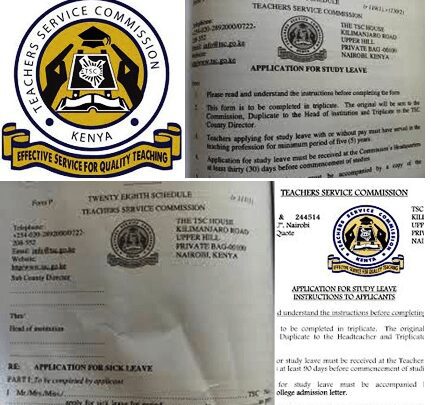How to create new TSC TPAD Account (https://tpad2.tsc.go.ke) for self Evaluation
TPAD is a performance evaluation mechanism that assesses the performance of a teacher as per the set standards prescribed by the Commission. Section 52 of the Code of Regulations for Teachers (2015) stipulates that the Commission shall in administering the performance appraisal system: –
- Require Heads of institution to provide oversight role in the performance appraisal for the teachers in their respective institutions;
- Use performance appraisal reports for purpose of promotion, deployment and other rewards as may be prescribed from time to time.
- Identify training needs and take corrective measures in cases of unsatisfactory performance.
- Develop and review criteria, guidelines and tools for performance appraisal from time to time which shall be accessible in the commission website or as the Commission may
How to create TSC TPAD Portal
To create a new TPAD account its simple and easier. Follow these steps:
- Click on https://tpad2.tsc.go.ke/auth/create_account to access the new account creation
- Fill in the fields shown
TSC Number ID Number
Phone Number (07xxxxxxxx) Email Address
Password Confirm Password
Mode of Notification
Create Account
- Click on ‘Create’ Once
- A success message is shown and you will receive SMS token on your phone within a short
- Enter the Code received via SMS and click on ‘Verify Token’. This completes the registration process.
Adding your Bio Data
Next, you need to add your level of Education and subject combination details.
- Add your information: Bio/ Institution Information, Contact
- Select ‘Subjects Combination’ and add your teaching subjects. Select your subjects combinations from the list and click on ‘Submit’ when
- Then, click on ‘Level of Education’ to add details. Select your KCSE grade, Highest level of Education and Institution of Study. Next, click on Submit.
ROLES OF THE TEACHERS IN THE NEW TPAD
Each teacher will be expected to do a self appraisal in the various areas, create an appraisal and upload the data online.
ROLES OF THE PRINCIPAL IN THE NEW TPAD
- Inducting new teachers on TPAD
- Capture the new teachers in TIMS
- Activating new teachers on TPAD
- Remove outgoing teachers
The Principal also performs the following roles in TPAD
- Provide oversight role in the performance appraisal for the teachers
- Continuously monitor and evaluate the appraisal process and submit termly reports
- Appraise the Deputy Principal
- Schedule meetings for appraising the Deputy Principal
- Observing the Deputy Principal
- Countersigning officer for all the teachers in the school Arbitration
ROLES OF THE DEPUTY PRINCIPAL IN THE NEW TPAD
- Update the Lesson Attendance
- Register on weekly basis
- Appraise the HODs and teachers
- Schedule meetings for appraising the HODs and teachers
- Observing the HODs and teachers
- Arbitration for the teachers
TPAD PROCESS-STEPS
| TPAD PROCESS-STEPS | |
| Step 1 | Development of appraisal Calendar |
| Step 2 | Setting Targets |
| Step 3 | Implementation of targets and gathering of evidence |
| Step 4 | Self -Appraisal and Standards based on competencies and standards |
| Step 5 | Appraisal rating by Appraiser based on evidence gathered. |
| Step 6 | Appraisal rating meeting between Appraiser and Appraisee (Question and Evidence. |
| Step 7 | Identification of gaps by Appraisee and Appraiser |
|
Step 8 |
Development and implementation of teacher support and performance development. |
NEW TPAD TEACHING STANDARDS
The new TPAD tool has 5 standards classified into 3 broad categories as follows:
SN ETEACHING STANDARDS TARGETS
- THE INSTRUCTIONAL
DELIVERY/TEACHING
- Professional Knowledge and Practice
Demonstrate mastery of the subject content and use appropriate instructional methods (Wt-3 Undertake lesson observation at least once a term (Wt-3)
Utilize teaching/ learning resources effectively (Wt-3)
Prepare professional documents based on the current syllabus/designs (Wt-3)
Ability to identify learners’ capability and learning styles (Wt-3)
Ability to identify and nurture learners’ talents (Wt-3)
Ability to access, retrieve and integrate ICT in teaching and learning (Wt-3)
2 Comprehensive Learning Environment
- Teacher Professional Development
B TEACHER CONDUCT AND PROFESSIONALISM
Ability to carry out learner assessment, feedback and reporting on learners’ learning (Wt-3) Ability to create child friendly school/class environment through planned activities to demonstrate respect, equity, inclusion and moral values (Wt- 3)
Ability to create a stimulating classroom environment (Wt-3)
Ability to ensure safety of learners (Wt-3)
Ability to manage learners conduct and behaviour (Wt-3)
Prepare Self Professional Development Support Plan (Wt-3)
Identification of professional gaps (Wt-3)
4 Teacher Conduct & Professionalism
C COMMUNITY PRACTICE
- Participation in Professional Learning Community
Ability to act in the best interest of the learner and maintain high standards of ethics and professional requirements within and outside the institution (Wt-6)
Demonstrate knowledge on the legal requirements in education (Wt-6).
Comply with the professional requirements in teaching and learning (Wt-6).
Ability to observe punctuality in lesson attendance, performance of duty and preparation of professional documents(Wt-6)
Timely syllabus coverage and meeting of deadlines (Wt-6)
Join Professional Learning Community (PLC) (Wt-5)
Collaborate with colleagues and the broader professional learning community to support teaching (Wt-5)
Collaborate with parents/guardians and other stakeholders (Wt-5)
Establish linkages with the community (Wt-5)
Participate in programs organized in collaboration with other educational bodies: KNEC, MOE, KICD etc. (Wt-5)
TPAD Procedure and Process (Appraisee, Appraiser and Countersign)
| APPRAISEE | APPRAISER | COUNTERSIGN/CONFIRM | |
|
1. |
Teacher in A Primary | Deputy Head of Institution/Senior Teacher |
Head of Institution |
| 2. | Senior Teacher in A Primary | Deputy Head of Institution | Head of Institution |
|
3. |
A Deputy Head of Institution In A Primary |
Head of Institution |
Sub County Director. |
|
4. |
A Head of Institution in A Primary | Sub County Director/CSO |
County Director/Scd |
|
5. |
A Teacher, Tutor or Lecturer in A Post- Primary | Head of Department/Deputy Head of Institution |
Head of Institution. |
|
6. |
A Head of Department in A Post-Primary | Deputy Head of Institution |
The Head of Institution. |
|
7. |
A Deputy Head of Institution in A Post-
Primary |
Head of Institution |
The Sub County Director |
|
8. |
A Head of Institution in A Post Primary | The Sub County Director |
County Director |





